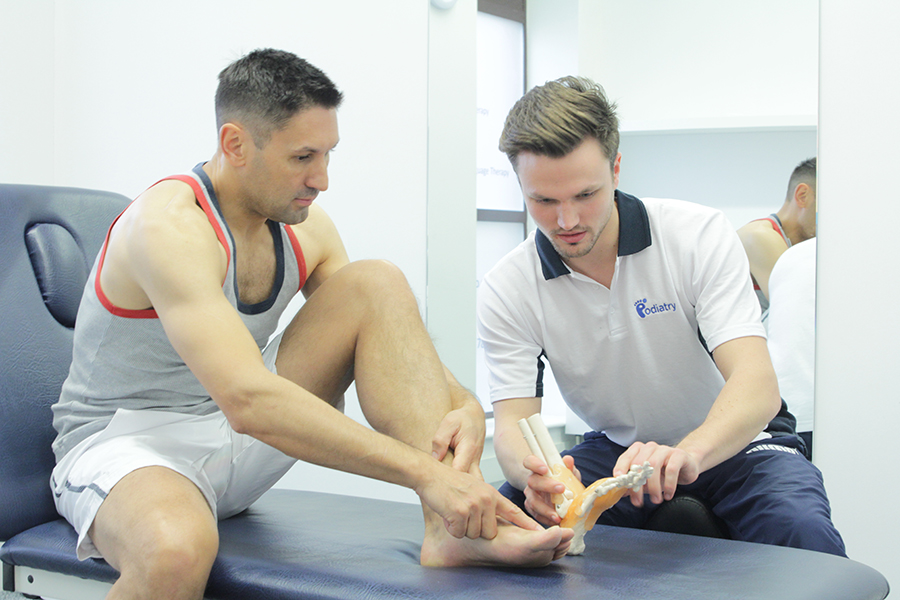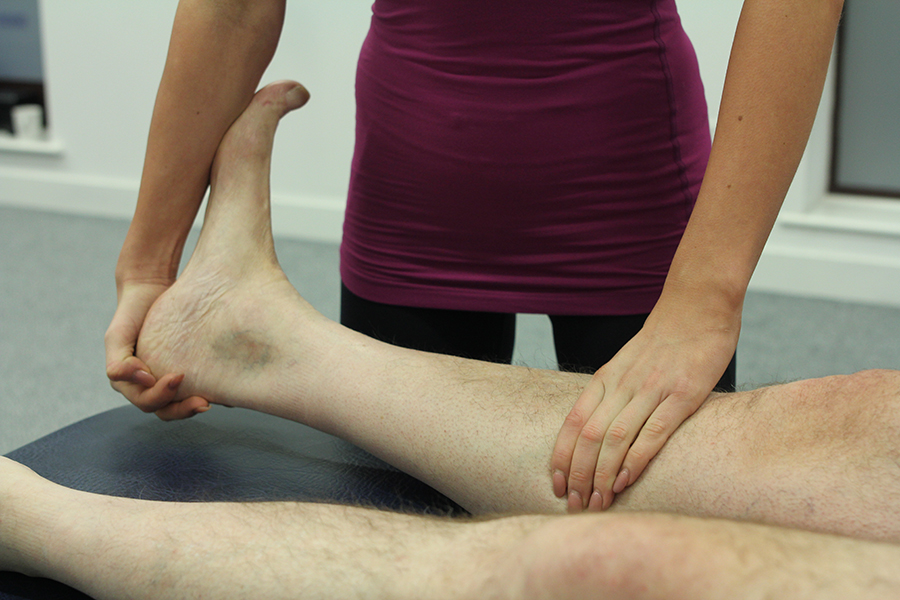Tarsal tunnel syndome
Tarsal tunnel syndrome, also known as the posterior tibial nerve dysfunction, is a form of peripheral neuropathy that affects the foot and ankle. Peripheral neuropathy describes a condition in which there is a loss of sensation and/or movement, and/or pain, in the foot and ankle due to compression or damage to the nerves outside of the brain and spinal cord. Tarsal tunnel syndrome occurs when the posterior tibial nerve is compressed.
What is tarsal tunnel syndrome?
Tarsal tunnel syndrome is a condition that occurs when the posterior tibial nerve becomes compressed and irritated. Nerve compression and irritation occur as the posterior tibial nerve passes down the leg and through a structure on the inner side of the ankle called the flexor retinaculum. The flexor retinaculum is a fibrous band of tissue that connects the tibia to the heel bone, it is positioned behind the medial malleolus (this is the bony lump on the inside of the ankle). The posterior tibial nerve provides movement and sensation to the calf muscles and the foot.
What causes tarsal tunnel syndrome?
Tarsal tunnel syndrome is a type of peripheral neuropathy that occurs when the posterior tibial nerve is compressed or damaged. Compression and damage to the posterior tibial nerve can lead to both sensory and motor symptoms. Compression and damage of the posterior tibial nerve may occur as a result of the following:
- Poor foot posture
- Trauma
- Inflammatory disorders
- Diabetes
When a nerve is compressed the nerve is under pressure, which can then damage the nerve. Damaged nerves can result in destruction of the nerves insulation (the myelin sheath) and when this happens nerve impulses can be interrupted.

What are the signs and symptoms of tarsal tunnel syndrome?
The signs and symptoms of tarsal tunnel syndrome include:
- Pain that radiates to the arch of the foot, and/or the heel and toes. The pain may be described as burning or tingling
- Tenderness under the medial malleolus (the bony lump on the inside of the ankle)
- Numbness on the bottom of the foot
- Numbness on the bottom of the foot
- Positive Tinnel's sign (this involves tapping the nerve so that the symptoms are reproduced)
How is tarsal tunnel syndrome diagnosed?
One of the podiatrists at Chiropody.co.uk will diagnose tarsal tunnel syndrome based on the signs and symptoms, a history of the problem, and an examination of the foot and ankle.
Benefits of podiatry for tarsal tunnel syndrome
If you have tarsal tunnel syndrome Chiropody.co.uk can help you. The following benefits may be achieved after podiatric assessment and treatment:
- Decrease in pain
- Reduction in neurological symptoms (e.g. tingling, numbness)
- Improved foot function
- Improved gait
Your podiatrist will advise you on the most appropriate anti-inflammatory,
the purpose of which is to treat and deal with the symptoms you are
experiencing 'now'. Sometimes topical and oral anti-inflammatory
medications do not sufficiently reduce the inflammation, and if this is the
case you may be given a steroid injection. Steroids are powerful
anti-inflammatories; inflammation produces pain, therefore, by reducing
inflammation the pain is also reduced.
To address the cause you may be prescribed orthoses. Orthoses are shoe
inserts that are tailored to your specific needs and requirements. In the
case of tarsal tunnel syndrome the orthoses aim is to alter the position of
the foot so that the nerve that is contributing to your symptoms is not
compressed.

What would podiatry for tarsal tunnel syndrome involve?
Podiatry for tarsal tunnel syndrome would involve obtaining a thorough history, which would include both a medical history, as well as a history of the problem, and the presenting signs and symptoms. The history would then be followed by an examination of the foot and ankle and a test that would aim to re-create any symptoms associated with tarsal tunnel syndrome, for example, the Tinnel's test. Once the podiatrist has made a diagnosis of tarsal tunnel syndrome the following treatment options may be discussed:
- Anti-inflammatory advice
- Rest
- Steroid injection
- Orthoses
- Advice and education
- Footwear modification
- Surgery
Summary
Tarsal tunnel syndrome is a form of peripheral neuropathy; this means that
it is a syndrome characterised by damage to the peripheral nerves.
Peripheral nerves are nerves outside of the brain and spinal cord.
Tarsal tunnel syndrome occurs as a result of compression to the posterior
tibial nerve, which courses down the back of the leg and through a fibrous
band of tissue called the flexor retinaculum situated on the inside of the
ankle. When the posterior tibial nerve is compressed it can become damaged,
leading to motor and sensory symptoms of the foot and ankle.
If you think you have tarsal tunnel syndrome one of our podiatrists here at
Chiropody.co.uk will be able to relieve the pressure on the nerve by
providing a pair of foot orthoses (shoe inserts). Foot orthoses can help
relieve the symptoms of tarsal tunnel syndrome by placing the foot into a
position that does not put pressure on the nerve.
To arrange an assessment with one our podiatrists please email office@chiropody.co.uk or call 0330 088 4222.
Save 5% by booking an appointment online.



We work with:

Individuals

Organisations

Health professionals
Get in Touch!
0330 088 4222
If you would like to speak to one of our specialists then please complete this form.
We are open 7 days a week








